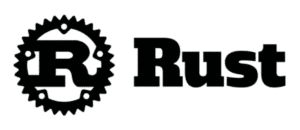Hiring Rust developer
- What Makes Rust Developers Essential for Your Project?
- Why Choose Upstaff to Hire Rust Developers?
- Our Hiring Process
- TOP 10 Rust Related Technologies
- What are top Rust instruments and tools?
- TOP 15 Facts about Rust
- TOP 15 Tech facts and history of creation and versions about Rust Development
- How and where is Rust used?
- Ready to Hire a Rust Developer?
What Makes Rust Developers Essential for Your Project?
Rust is a modern, high-performance programming language renowned for its memory safety, concurrency, and speed. Hiring Rust developers through Upstaff empowers your business to:
Develop memory-safe applications without sacrificing performance, ideal for system-level programming and blockchain.
Build scalable backends using frameworks like Actix and Diesel for web applications and microservices.
Create secure blockchain solutions with expertise in Solana, Substrate, and smart contract development.
Optimize performance-critical systems with Rust’s low-level control, perfect for CLI tools and WebAssembly.
Our Rust developers bring years of experience, with many having worked on projects involving real-time applications, distributed systems, and decentralized technologies.
Why Choose Upstaff to Hire Rust Developers?
Upstaff connects you with the top 3.5% of Rust developers, rigorously vetted for expertise in building high-performance applications. Our developers have hands-on experience with Rust’s ecosystem, including frameworks like Actix, Tokio, and Diesel, and are skilled in delivering secure, concurrent, and scalable solutions. Whether you need a Rust engineer for blockchain development, CLI tools, or web backends, Upstaff streamlines the hiring process to save you time and resources.
Vetted Talent: Our AI-driven vetting process ensures you work with Rust developers who have proven track records in delivering complex projects.
Fast Hiring: Find and onboard Rust engineers in as little as 48 hours, with no hidden costs or lengthy recruitment cycles.
Diverse Expertise: From WebAssembly to microservices, our Rust developers bring specialized skills to meet your project needs.
Flexible Solutions: Hire for short-term projects, long-term engagements, or build an entire Rust development team.
Our Hiring Process
Share Your Requirements: Tell us about your project, technical needs, and timeline.
Candidate Sourcing: We use our proprietary platform to source 15-30 pre-vetted Rust developers tailored to your needs.
Screening & Interviews: Our team conducts thorough skill assessments, and you can interview top candidates.
Onboarding: Hire your chosen Rust developer and start your project in as little as 48 hours.
Support & Scaling: Get ongoing support and the flexibility to scale your team as needed.
TOP 10 Rust Related Technologies
Rust Programming Language
Rust is a systems programming language that emphasizes safety, speed, and concurrency. It is known for its strong type system and memory safety features, making it a popular choice for building robust and reliable software.
Actix Web Framework
Actix is a powerful, actor-based web framework for Rust. It provides a high-performance, asynchronous foundation for building scalable and efficient web applications. With its ergonomic API and extensive ecosystem, Actix is widely used in the Rust community.
Diesel ORM
Diesel is a powerful object-relational mapping (ORM) library for Rust. It provides a type-safe and composable query builder, allowing developers to interact with databases in a safe and efficient manner. Diesel is a popular choice for Rust developers working with databases.
Rocket Web Framework
Rocket is a web framework for Rust that focuses on simplicity and ease of use. It provides intuitive macros and a familiar API, allowing developers to quickly build web applications. Rocket is gaining popularity in the Rust community due to its developer-friendly approach.
Tokio
Tokio is an asynchronous runtime for Rust that enables efficient and scalable networking applications. It provides a set of tools and abstractions for building asynchronous I/O applications, making it an essential technology for high-performance Rust software development.
Serde
Serde is a powerful serialization and deserialization library for Rust. It allows developers to easily convert Rust data structures to and from various formats, such as JSON and YAML. Serde is widely used in the Rust ecosystem and plays a crucial role in data manipulation and communication.
Clippy
Clippy is a linting tool for Rust that helps developers write idiomatic and efficient code. It provides a set of helpful warnings and suggestions to catch potential bugs and improve code quality. Clippy is widely adopted in the Rust community to ensure code correctness and maintainability.
What are top Rust instruments and tools?
- Rust Language Server: The Rust Language Server (RLS) is an essential tool for Rust developers. It provides features like code completion, jump-to-definition, and documentation lookup. The RLS has been under development since 2016 and is widely used in Rust IDEs such as Visual Studio Code with the Rust plugin.
- Cargo: Cargo is the official package manager and build system for Rust. It was introduced in 2011 alongside the Rust programming language. Cargo is known for its simplicity and ease of use, handling tasks like dependency management, building, testing, and documentation generation. It has become an integral part of the Rust ecosystem.
- Rustfmt: Rustfmt is a tool for formatting Rust code according to a set of community-driven style guidelines. It automatically formats code, making it consistent and easier to read. Rustfmt has been around since 2016 and is widely used by Rust developers to ensure code quality and maintainability.
- Rust Analyzer: Rust Analyzer is a powerful IDE-independent Rust analysis tool. It provides features such as code navigation, refactoring, and error checking. Rust Analyzer aims to be a faster and more reliable replacement for the RLS, and it has gained popularity among Rust developers since its introduction in 2020.
- Rustdoc: Rustdoc is the documentation generator for Rust code. It takes specially formatted comments, known as doc comments, and generates HTML documentation. Rustdoc has been an integral part of the Rust toolchain since the early days of the language, helping developers create and share well-documented libraries and projects.
- Cargo-edit: Cargo-edit is a command-line tool that extends Cargo’s functionality by allowing developers to add, remove, and manage dependencies directly from the command line. It simplifies the process of managing project dependencies and is widely used by Rust developers for package management tasks.
- Rustup: Rustup is a toolchain installer and manager for Rust. It allows developers to easily install and switch between different versions of the Rust compiler. Rustup also manages the installation of associated tools like Cargo and Rustfmt. It has been the recommended way to install Rust since 2016.
- Rustlings: Rustlings is an interactive learning tool for Rust. It provides a series of exercises and small projects to help beginners learn the Rust programming language. Rustlings has gained popularity for its hands-on approach to learning Rust and has been used by many developers to kickstart their Rust journey.
TOP 15 Facts about Rust
- Rust is a systems programming language that focuses on safety, speed, and concurrency.
- It was developed by Mozilla and first announced in 2010, with its stable release in 2015.
- Rust was designed to address the shortcomings of other languages, such as C and C++, by providing memory safety without sacrificing performance.
- The language’s syntax is similar to C++, making it relatively easy for C++ developers to learn and adopt.
- Rust’s ownership system allows for strict control over memory allocation and deallocation, preventing common issues like null pointer dereferences and data races.
- It enforces strict compile-time checks to ensure memory safety, making it virtually impossible to have certain types of runtime errors.
- Rust’s strict borrowing rules prevent multiple mutable references to the same data, eliminating data races and making it easier to write concurrent code.
- It has built-in support for concurrent programming through its ‘async/await’ syntax, allowing developers to write efficient and scalable code.
- Rust has a rich ecosystem of libraries and frameworks, making it suitable for a wide range of applications, from low-level system programming to web development.
- Several major companies, including Dropbox, Amazon, and Microsoft, have adopted Rust for various projects, highlighting its growing popularity and industry recognition.
- According to the Stack Overflow Developer Survey 2021, Rust has been voted the most loved programming language for the sixth consecutive year, indicating high developer satisfaction and enthusiasm for the language.
- It has a thriving and active community that provides extensive documentation, tutorials, and support for developers, making it easier to learn and collaborate.
- Rust’s compiler, known as ‘rustc,’ is known for its powerful static analysis capabilities, catching many common programming errors at compile time.
- The language’s package manager, called ‘Cargo,’ simplifies the process of managing dependencies and building projects, enhancing developer productivity.
- Rust has cross-platform support, allowing developers to write code that runs on various operating systems, including Windows, macOS, Linux, and even embedded systems.
TOP 15 Tech facts and history of creation and versions about Rust Development
- Rust is a systems programming language known for its strong memory safety guarantees and the prevention of data races.
- It was created by Mozilla employee Graydon Hoare, who started development in 2006 and released the first version in 2010.
- Rust’s design was heavily influenced by other programming languages, including C++, Haskell, and OCaml.
- The language gained popularity due to its focus on performance, safety, and concurrency.
- Rust introduced the concept of ownership, borrowing, and lifetimes, which help prevent common programming errors.
- In 2015, Rust 1.0 was released, marking the language’s stability and readiness for production use.
- Since its release, Rust has seen significant growth in its community and adoption by companies like Mozilla, Dropbox, and Microsoft.
- Rust’s package manager, Cargo, simplifies dependency management and building projects, making it easier for developers to get started.
- The Rust community values documentation and has created extensive resources, such as The Rust Programming Language book and Rust by Example.
- Rust has a strong focus on safety, with its “zero-cost abstractions” philosophy, allowing high-level abstractions without sacrificing performance.
- The language’s borrow checker enforces strict rules on memory usage, preventing common bugs like null pointer dereferences and use-after-free errors.
- Rust’s fearless concurrency model allows for safe concurrent programming by enforcing strict rules around shared mutable state.
- Web developers can leverage Rust through frameworks like Rocket and Actix, which provide high-performance web server capabilities.
- Rust’s ecosystem includes a wealth of libraries and frameworks for various domains, such as networking, cryptography, and game development.
- Rust is designed to be a language for the next 40 years, with a focus on stability, backwards compatibility, and long-term support.
How and where is Rust used?
| Case Name | Case Description |
|---|---|
| 1. Dropbox | Rust is used extensively at Dropbox for various purposes. It is used for building critical systems that handle metadata storage and synchronization. Rust’s memory safety guarantees and performance optimizations make it a suitable choice for handling large-scale data storage and retrieval, ensuring the reliability and speed of Dropbox’s services. |
| 2. Firefox | Rust has been adopted by Mozilla for developing components of the Firefox web browser. One notable example is the Quantum CSS engine, which is written in Rust. By leveraging Rust’s memory safety and concurrency features, Firefox benefits from improved performance, security, and stability. |
| 3. Cloudflare | Cloudflare, a leading provider of internet security and performance services, utilizes Rust for developing its edge server infrastructure. Rust’s low-level control and memory safety features allow Cloudflare to build high-performance networking components that can handle massive amounts of traffic while maintaining robust security measures. |
| 4. Discord | The popular communication platform Discord has incorporated Rust into its codebase for various performance-critical tasks. Rust’s ability to provide zero-cost abstractions and prevent common programming errors makes it well-suited for handling real-time voice and video communication, ensuring a seamless user experience. |
| 5. Nushell | Nushell, a modern shell that focuses on simplicity and extensibility, is built entirely in Rust. The language’s expressive syntax and memory safety features enable developers to create a user-friendly command-line interface with powerful data manipulation capabilities, making it a valuable tool for data scientists and system administrators. |
| 6. TiKV | TiKV, an open-source distributed transactional key-value database, is developed in Rust. Rust’s strong type system and runtime performance make it an ideal choice for building a database that can handle high-throughput and low-latency workloads, ensuring data consistency and reliability. |
| 7. Redox OS | Redox OS is a Unix-like operating system written in Rust. By utilizing Rust’s memory safety and concurrency features, Redox OS aims to provide a secure and efficient platform for running applications. Rust’s focus on preventing common programming errors helps in mitigating security vulnerabilities often found in traditional operating systems. |
| 8. Parity Ethereum | Parity Ethereum, one of the widely used Ethereum clients, is implemented in Rust. Rust’s performance, memory safety, and concurrency features enable Parity Ethereum to handle the complex requirements of the Ethereum blockchain, ensuring efficient and secure execution of smart contracts. |
| 9. Amethyst | Amethyst is a data-driven game engine written in Rust. Rust’s memory safety guarantees and performance optimizations make it a suitable choice for developing resource-intensive game engines. Amethyst leverages Rust’s features to provide a robust and efficient framework for building high-quality games. |
Ready to Hire a Rust Developer?
Don’t let slow hiring processes hold back your project. Partner with Upstaff to find expert Rust developers who can deliver secure, high-performance solutions tailored to your needs. Contact us today to get started!
- What Makes Rust Developers Essential for Your Project?
- Why Choose Upstaff to Hire Rust Developers?
- Our Hiring Process
- TOP 10 Rust Related Technologies
- What are top Rust instruments and tools?
- TOP 15 Facts about Rust
- TOP 15 Tech facts and history of creation and versions about Rust Development
- How and where is Rust used?
- Ready to Hire a Rust Developer?
Talk to Our Expert


